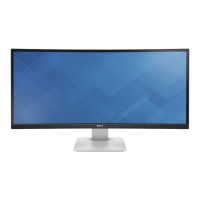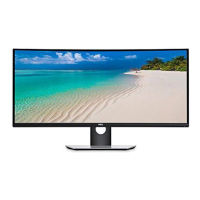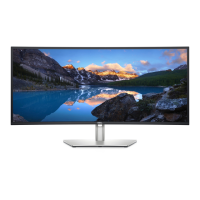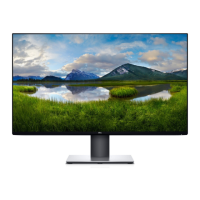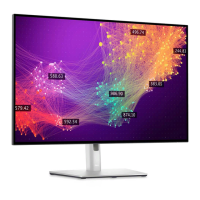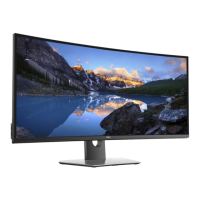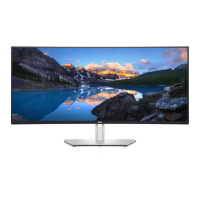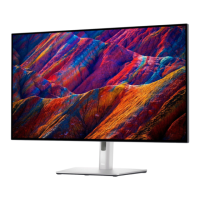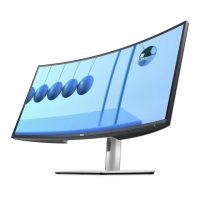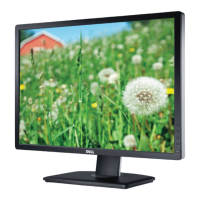Do you have a question about the Dell UltraSharp U3419W and is the answer not in the manual?
Explains the meaning of NOTE, CAUTION, and WARNING symbols for user guidance.
Lists items included with the monitor upon purchase.
Describes the monitor's key capabilities and functionalities.
Identifies controls and buttons located on the monitor's front panel.
Identifies ports, VESA mount holes, and labels on the monitor's back.
Identifies USB ports located on the monitor's side.
Identifies power, security, HDMI, DisplayPort, and USB ports on the bottom.
Technical details on screen panel type, dimensions, and resolution capabilities.
Supported video modes, electrical requirements, and connector types.
Dimensions, weight, and operating environment requirements for the monitor.
Details on monitor power saving features and modes.
Step-by-step guide to securely attach the monitor stand.
Instructions for connecting HDMI and DisplayPort cables.
Instructions for connecting USB Type-C and USB 3.0 cables.
Tips for cable organization and detaching the monitor stand.
Guidelines for mounting the monitor on a wall.
How to turn on the monitor and use the front panel buttons.
How to use the On-Screen Display menu for adjustments.
Configuring brightness, contrast, color, and display modes.
Using multi-window display, audio, and customizing OSD settings.
Setting max resolution and physical adjustments like tilt, swivel.
Running self-test and built-in diagnostics for issue identification.
Addressing frequent issues with potential solutions.
Troubleshooting USB interface and speaker problems.
Essential safety precautions and compliance notices.
How to get technical assistance and support.
Explains the meaning of NOTE, CAUTION, and WARNING symbols for user guidance.
Lists items included with the monitor upon purchase.
Describes the monitor's key capabilities and functionalities.
Identifies controls and buttons located on the monitor's front panel.
Identifies ports, VESA mount holes, and labels on the monitor's back.
Identifies USB ports located on the monitor's side.
Identifies power, security, HDMI, DisplayPort, and USB ports on the bottom.
Technical details on screen panel type, dimensions, and resolution capabilities.
Supported video modes, electrical requirements, and connector types.
Dimensions, weight, and operating environment requirements for the monitor.
Details on monitor power saving features and modes.
Step-by-step guide to securely attach the monitor stand.
Instructions for connecting HDMI and DisplayPort cables.
Instructions for connecting USB Type-C and USB 3.0 cables.
Tips for cable organization and detaching the monitor stand.
Guidelines for mounting the monitor on a wall.
How to turn on the monitor and use the front panel buttons.
How to use the On-Screen Display menu for adjustments.
Configuring brightness, contrast, color, and display modes.
Using multi-window display, audio, and customizing OSD settings.
Setting max resolution and physical adjustments like tilt, swivel.
Running self-test and built-in diagnostics for issue identification.
Addressing frequent issues with potential solutions.
Troubleshooting USB interface and speaker problems.
Essential safety precautions and compliance notices.
How to get technical assistance and support.
| Color | black |
|---|---|
| Screen Type | led |
| Tiltable | yes |
| Wall Mount | 100mm x 100mm |
| OS Compatibility | mac, windows |
| Screen Size | 34.14 inches |
| Panel Type | ips |
| Aspect Ratio | 21:9 |
| Resolution | 3440 x 1440 |
| Native Resolution | 3440 x 1440 |
| Refresh Rate | 60hz |
| Horizontal Viewing Angle | 178 degrees |
| Vertical Viewing Angle | 178 degrees |
| Response Time | 5 milliseconds |
| Brightness | 300 candela per square meter |
| Contrast Ratio | 1000:1 |
| Pixel Pitch | 109 pixels per inch |
| Headphones Output | yes |
| Power Saving Mode | 0.5 watts |
| Power Consumption | 54 watts |
| Depth with Stand | 8.9 inches |
| Width with Stand | 32 inches |
| Depth without Stand | 2.3 inches |
| Height without Stand | 14.3 inches |
| Net Weight without Stand | 24.5 pounds |
